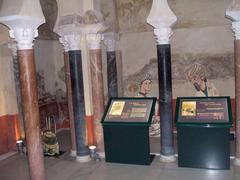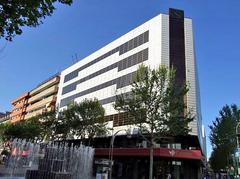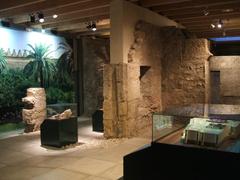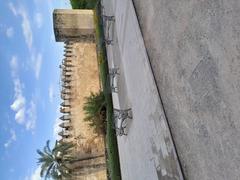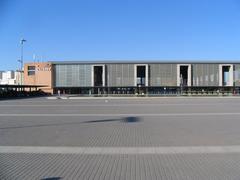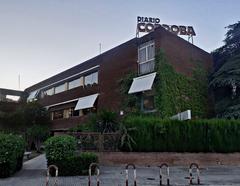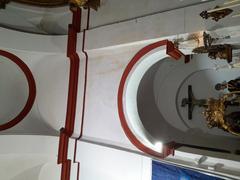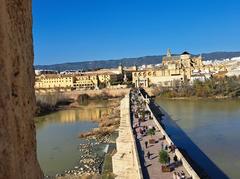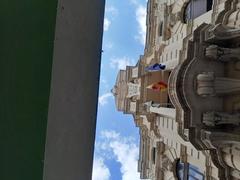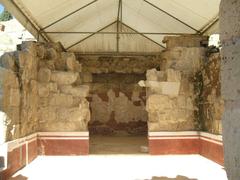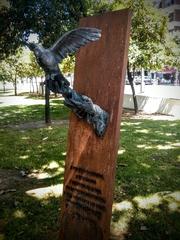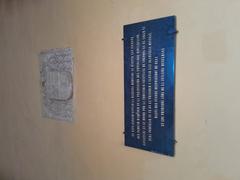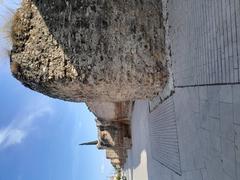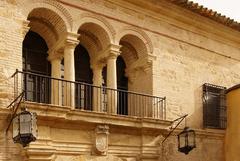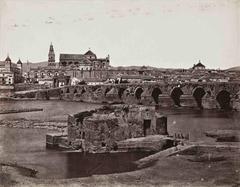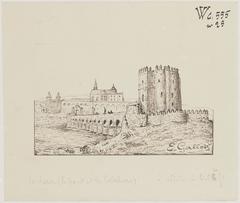Complete Guide to Colegio Las Escolapias: Visiting Hours, Tickets, and Historical Significance in Córdoba, Spain
Date: 14/06/2025
Introduction
Colegio Las Escolapias, also known as Colegio Santa Victoria and Colegio San José de Cabra, is a cornerstone of Córdoba’s educational and cultural landscape. Set in the historic Casa-Palacio de los Condes de Cabra, this institution has, since its late 19th-century founding, exemplified the union of faith, education, and architectural heritage. The legacy of Saint Joseph Calasanz and Santa Paula Montal—champions of girls’ education in Spain during an era of restricted female access—is woven into every aspect of the school’s mission and physical presence (Escolapias.es, ABC).
Today, Colegio Las Escolapias stands not only as an active school but also as a unique cultural and architectural landmark. It boasts a confluence of Roman, Muslim, Baroque, Gothic, Renaissance, and Mudejar influences. Within its walls, visitors can discover the historic Capuchin convent church, a Baroque chapel adorned with Juan de Valdés Leal’s masterpiece, and the crypt of the Counts of Cabra (Cabra en el Recuerdo, escolapias.es).
This comprehensive guide provides all essential visitor information: from hours and ticketing to accessibility, guided tours, and nearby attractions such as the Mezquita-Catedral and Alcázar de los Reyes Cristianos. Whether your interest lies in the school’s educational mission, its architectural treasures, or its vibrant role in the local community, you’ll find practical advice and cultural context to enrich your visit (Fundación Educativa Escolapias, turismodecordoba.org).
Table of Contents
- Introduction
- Historical Overview
- Visiting Colegio Las Escolapias: Practical Information
- Architectural Heritage: A Closer Look
- The Santa Victoria Monument: History, Access, and Visitor Tips
- Frequently Asked Questions (FAQ)
- Summary and Travel Advice
- References
Historical Overview
Origins and Early History
Colegio Las Escolapias belongs to the Escolapias movement, or the Congregation of the Daughters of Mary, Religious of the Pious Schools. Founded by Santa Paula Montal in 1829 in Figueras, Catalonia, the movement was revolutionary in its commitment to quality education for girls—a rarity in 19th-century Spain (Escolapias.es). Montal’s aim was to nurture intellectual, moral, and spiritual growth, promoting family, faith, and social responsibility.
As the Escolapias network grew, it established a presence throughout Spain, including Andalusia. The Córdoba foundation met local needs for accessible, principled education.
Establishment in Córdoba: Casa-Palacio de los Condes de Cabra
The Colegio San José de Cabra, officially opened on November 26, 1899, occupies the Casa-Palacio de los Condes de Cabra—a site with roots stretching to Roman times (Cabra en el Recuerdo). The building, rich in architectural history, was adapted for educational use by the Madres Escolapias. The school’s church, formerly a Capuchin convent, adds further religious and architectural depth.
Educational Mission and Evolution
From its inception, Colegio Las Escolapias has championed an education rooted in Catholic values, inclusivity, and critical thinking (Fundación Educativa Escolapias). The school has evolved with the times, updating curricula and teaching methods while maintaining its dedication to service, compassion, and the common good.
Architectural and Cultural Significance
The Casa-Palacio de los Condes de Cabra is a prime example of Córdoba’s layered history. Its architecture reveals Roman, Muslim, and Christian influences, and the school’s custodianship of the site underscores its commitment to preserving local heritage (Cabra en el Recuerdo). The campus serves as a hub for religious and cultural events, reinforcing its community role.
Integration into Fundación Educativa Escolapias
In 2013, the school joined the Fundación Educativa Escolapias, strengthening its networked educational mission and fostering innovation, social engagement, and spiritual growth (Fundación Educativa Escolapias).
The Escolapias Legacy in Córdoba
For over a century, Colegio Las Escolapias has nurtured generations of students, advancing gender equality and community service. Its impact on women’s education and its role in societal progress are widely recognized (Escolapias.es).
Notable Milestones
- 1899: Official opening in Casa-Palacio de los Condes de Cabra.
- Early 20th century: Expansion and modern teaching reforms.
- Post-1970s: Integration of technology and contemporary curricula.
- 2013: Joining Fundación Educativa Escolapias.
Visiting Colegio Las Escolapias: Practical Information
Visiting Hours
- Córdoba Site: Primarily an active school, open to visitors Monday–Friday, 8:00 AM–5:00 PM. Special open days and guided tours are offered occasionally—check in advance.
- Cabra Site: Open Monday–Friday, 9:00 AM–6:00 PM; guided tours (chapel and crypt) on Saturdays, 10:00 AM–2:00 PM (ABC).
Tickets and Access
- Exterior Viewing: Free; no ticket required.
- Guided Tours/Special Events: Tickets may be required (typically €5 adults, €3 students/seniors at Cabra). Book online via the official tourism or school website or at the reception (Official Cabra Tourism Website).
Accessibility
- Córdoba: Some areas have limited accessibility due to historic architecture; contact the school for accommodations.
- Cabra: Wheelchair accessible, with ramps and elevators throughout.
Visitor Amenities
- Restrooms, café, gift shop (Cabra).
- Dining facilities and recreational patios.
- Spaces for workshops and community events.
Special Events and Tours
The school hosts religious celebrations, open days, and participates in local festivals such as the medieval celebrations of La Villa. These occasions provide opportunities to access areas typically closed to the public. Check the school’s website or local tourism boards for schedules.
Nearby Attractions
Enhance your visit with nearby landmarks:
- Mezquita-Catedral
- Alcázar de los Reyes Cristianos
- Roman Bridge
- Historic Jewish Quarter
Architectural Heritage: A Closer Look
Historical Evolution and Layout
The campus comprises traditional Andalusian courtyards, whitewashed walls, and arcaded walkways. Its evolution—from the original 1888 Santa Victoria building to later expansions—mirrors educational and architectural trends (escolapias.es).
Styles and Notable Spaces
- Santa Victoria Building: Neoclassical façade, wrought-iron balconies, Baroque chapel with stained glass.
- San Rafael Building (1922): Classrooms around an open courtyard.
- San Joaquín Estate (1923): Residential-style, with gardens and local stonework.
Decorative Elements
Visitors can admire:
- Mudejar and Gothic arches
- Intricate azulejos (tiles)
- Religious iconography (statues, Marian symbols)
Modern Facilities
Recent adaptations include:
- Early childhood education center (2001)
- Digital classrooms and energy-efficient solutions (escuelaspiasdecordoba.edu.ar)
Community and Cultural Spaces
The chapel and oratories are focal points for reflection, while multipurpose halls and gardens enhance academic and community life. The school’s role as a wartime hospital during the Spanish Civil War adds further historical resonance (escolapias.es).
The Santa Victoria Monument: History, Access, and Visitor Tips
Historical Significance
The Santa Victoria monument, declared a Bien de Interés Cultural in 1983, is among Córdoba’s oldest educational charities. Its mission to empower women through education is evident in both its architecture and programming (escolapiassantavictoria.com).
Location and Highlights
Located at Calle Santa Victoria 1, the building blends Renaissance and Baroque elements. Notable features include the ornate courtyard, historic chapel, and crypt.
Visiting Information
- Hours: Tuesday–Sunday, 10:00 AM–6:00 PM; closed Mondays/holidays.
- Tickets: €5 adults, €3 seniors, free for students/children. Group discounts available.
- Guided Tours: Weekends, 11:00 AM & 4:00 PM; book ahead.
Getting There
- Bus: Lines 3, 7, and 12.
- On foot: Short walk from main train station and Mezquita-Catedral.
Accessibility & Amenities
- Wheelchair access and assistance available.
- Restrooms, café, and gift shop on site.
Special Events & Exhibitions
Artistic and educational events occur year-round; check official sites for schedules.
Photo Opportunities
Capture the Baroque chapel, courtyard, and palace entrance. Photography is allowed (no flash/tripods).
Frequently Asked Questions (FAQ)
Q: What are the visiting hours?
A: Monday–Friday, 8:00 AM–5:00 PM (Córdoba); Monday–Friday, 9:00 AM–6:00 PM (Cabra); special tours on Saturdays and by appointment (ABC).
Q: Are tickets required?
A: Exterior viewing is free. Guided tours or special events may require tickets.
Q: Is the site accessible?
A: Cabra site is fully accessible; some areas of Córdoba are limited due to historic structures.
Q: Are group tours available?
A: Yes, with advance booking.
Q: Can I take photos?
A: Yes, except with flash or tripods in sensitive areas.
Q: What other sites are nearby?
A: Mezquita-Catedral, Alcázar de los Reyes Cristianos, Roman Bridge, and more.
Summary and Travel Advice
Colegio Las Escolapias (Santa Victoria) is an enduring testament to Córdoba’s educational innovation and cultural richness. Home to centuries-old architecture and a vibrant academic tradition, the site invites visitors to experience its heritage through guided tours, special events, and community activities (Escolapias.es, ABC, Cabra en el Recuerdo, turismodecordoba.org).
Leverage official resources for the latest updates on hours, tickets, accessibility, and events. Consider combining your visit with tours of Córdoba’s other historic landmarks for a well-rounded cultural itinerary. For travel tips, event news, and exclusive content, download the Audiala app and follow related social media channels.
References
- Escolapias.es
- ABC
- Cabra en el Recuerdo
- Fundación Educativa Escolapias
- Turismodecordoba.org
- Escolapiassantavictoria.com
- Escuelaspiasdecordoba.edu.ar
- Travelpander.com
- Escolapias de Castilla Official Site
- Official Cabra Tourism Website
Visuals: For a richer experience, refer to the official websites for images of the Casa-Palacio exterior, the Baroque chapel interior, and a map of the La Villa district. Alt tags should include “Colegio Las Escolapias chapel Baroque art” and “Casa-Palacio de los Condes de Cabra entrance.”
